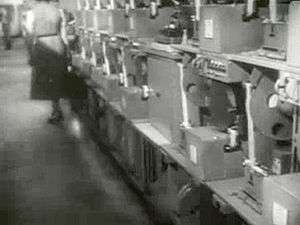Plan 55-A
Plan 55-A was one in a series of store and forward message switching systems developed by Western Union and used from 1948 to 1976 for processing telegrams.[1] It is an automated successor to Plan 51, which commenced service in 1951 in a nationwide network of the U.S. Air Force, but required semi-automatic operation.[2][3]

Based on the technology of punched paper tape storage, the systems of the design were called reperforators. A reperforator performed functions similar to an email message transfer agent (email server), used much later in the Internet, but it used electro-mechanical technology, which preceded the use of semiconductor circuitry and computers.
A reperforator switching center received messages via serial communication lines from teleprinters, such as the Teletype Model 28 ASR, or from other switching centers on receiving consoles, each consisting of a paper tape punch feeding tape into a paper tape reader via a storage bin. The reader decoded the message header, and sent the header characters to the director. The director, much like a telephone switch, connected the receiving console to a sending console in the same switching center by a cross-office connection. The message was transmitted from the receiving console to the sending console, character by character, punching a second paper tape at the sending console. Cross-office connections, and their readers and punches, were slightly faster than external connections, to limit congestion to the edges of the network.
Each sending console also consisted of a paper tape punch and reader. Output from each sending console was transmitted via outgoing lines to other switching centers or to destination teleprinters.[3] Each message typically contained one telegram.
Each received message had up to nine routing indicators, or destinations. For two or three destinations, the messages were sent simultaneously on three cross-office connections to outgoing sending consoles. Additional destinations resulted in a copy of the message being sent to the multiple call spillover unit, which removed the routing indicators for destinations already handled and sent the message through the system again.[3]
Nationwide, Western Union's switching centers were arranged in a hub and spokes architecture involving fifteen locations. The U.S. Air Force used the Plan 55-A system worldwide with ten centers.
An analysis of the queueing delays in Plan 55-A by Leonard Kleinrock[4] formed part of the theoretical basis for the development of the ARPAnet.
See also
References
- "The Decline and Fall of the Reperforator". Western Union News. Western Union. 10 (5). May 5, 1977.
- Vernam, G.S. (May 1958). "Automatic Telegraph Switching System Plan 55-A". Transactions of the American Institute of Electrical Engineers. IEEE: 239–247. doi:10.1109/TCE.1958.6372793.
- Private Wire Services - Plan 55 Switching System - Equipment Description FWS-10 (PDF). Western Union. June 1, 1957. Archived from the original (PDF) on April 29, 2009.
- Kleinrock, Leonard (December 1962). "Message Delay in Communication Nets with Storage (PhD thesis)" (PDF). Cambridge: Massachusetts Institute of Technology. Cite journal requires
|journal=(help)
External links
- Western Union Telegraph Company (1956). "Telegram for America". A non-technical industrial film showing telegram handling in the 1950s. Plan 55-A switching centers are shown in some detail.